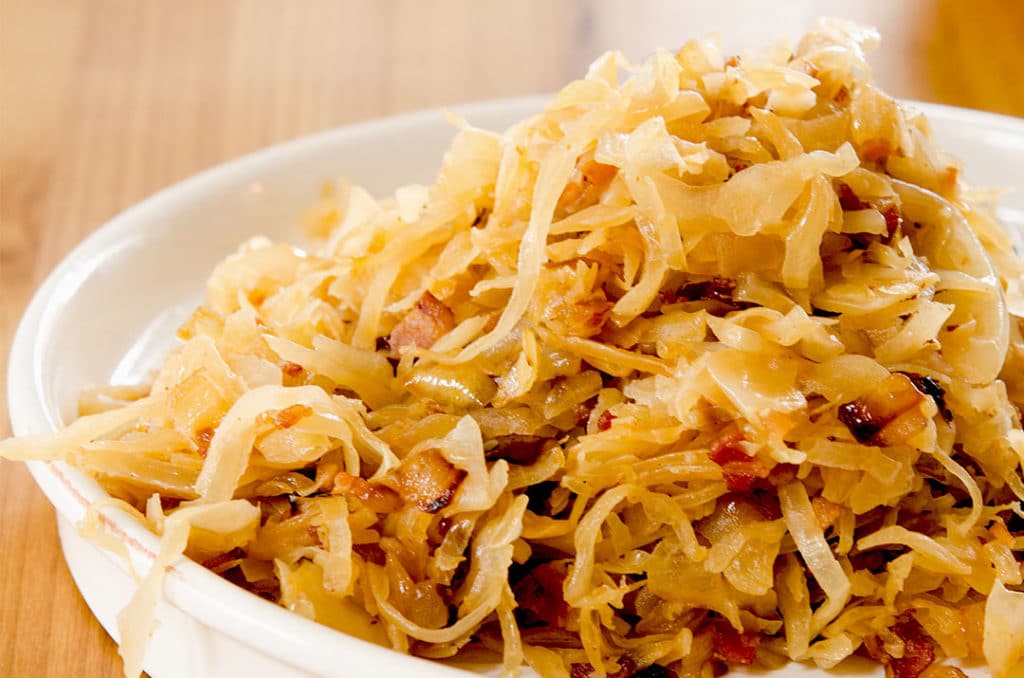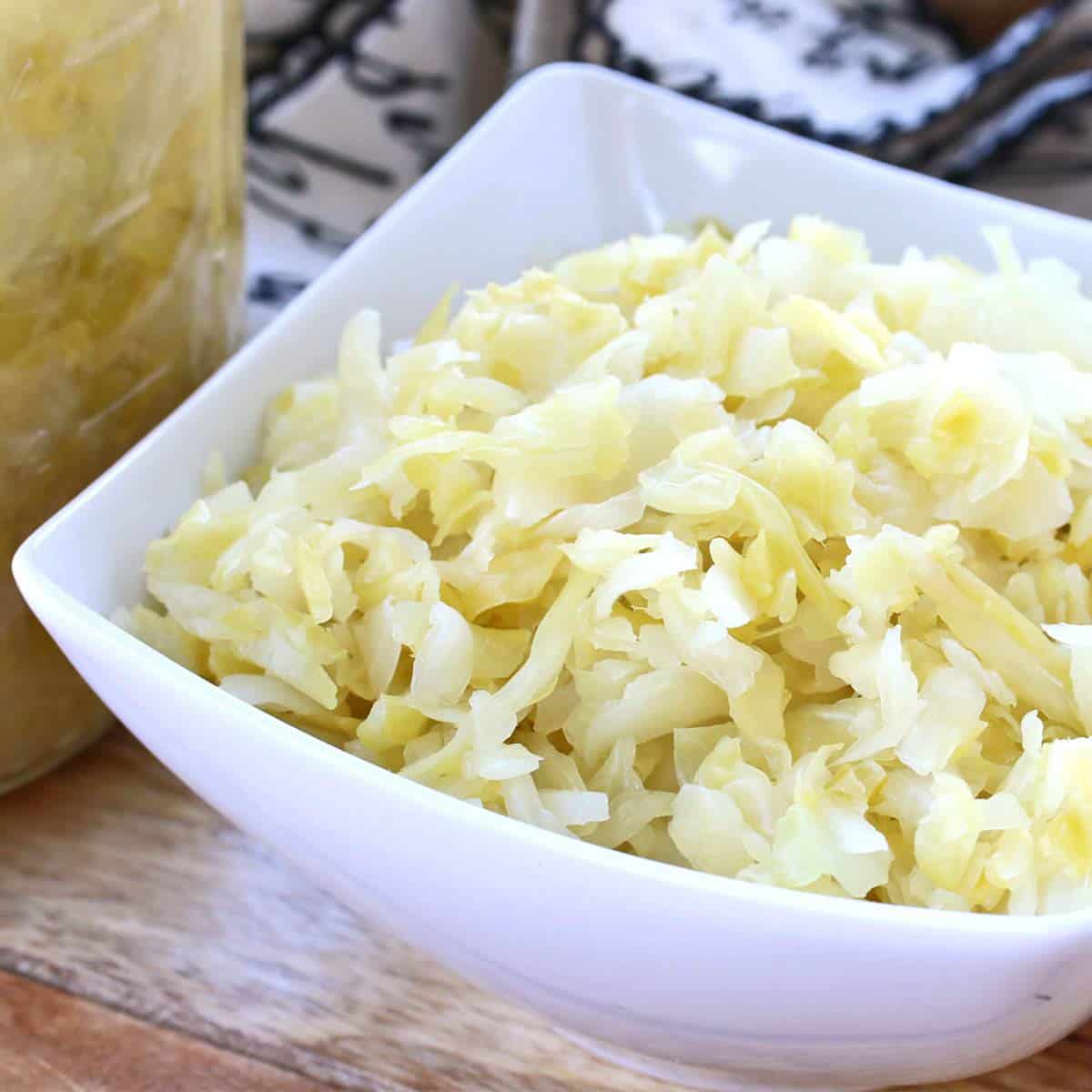A comprehensive, step-by-step pictured tutorial on How to Make Sauerkraut that is incredibly healthy and delicious! Making your own fermented homemade sauerkraut is super easy, requires minimal prep work, and the rest is just a waiting game!
Sauerkraut is in my blood. Being from Germany and raised by a health-conscious mom, I ate this stuff on a regular basis. In Germany sauerkraut is eaten fresh or cooked in a wide variety of dishes; everything from casseroles and soups to salads or alongside meats and sausages. Raw fermented sauerkraut was always readily available in our local health food stores. My mom and I regularly went to our local Reformhaus and in the refrigerated section was a large vat of fresh sauerkraut where we could scoop out as little or as much as we wanted into the bags provided. We’d often nibble on some of it as we made our way through the outdoor shopping district and then take the rest home with us. This ancient skill has been making a comeback in recent years both overseas and in the U.S., with a growing number of people learning how to ferment their own foods.
I’ve been fermenting vegetables, grains, legumes, and dairy products for over a decade and it is a deeply satisfying venture. If you’ve been curious about how to make sauerkraut it’s time to make that leap.
For anyone interested in trying their hand at fermentation, sauerkraut is the perfect place to start!

How to Make Sauerkraut

Making your own sauerkraut is super easy, requires minimal prep work, and the rest is just a waiting game. Enjoy all the health benefits of the vibrant probiotics and the superior taste of homemade sauerkraut!
Prep: 20min
Total: 20180min
Ingredients:
- 1 1/2-2 teaspoons salt for every pound of cabbage (9-12 grams salt per 450 grams of cabbage)
- very fresh green cabbage
Instruction:
- Prepare the Cabbage:Remove any bruised or damaged exterior leaves from the cabbage, then cut the cabbage in half and remove the core. Slice the cabbage very thinly, approximately 1/8 inch thick. For the best texture we recommend slicing it very thinly by hand, not with a food processor. You can slice it by hand, use a mandolin, or cabbage slicer.Place the sliced cabbage in a large bowl and toss in the salt. Let it sit for about 20 minutes until the cabbage has begun to wilt and releases some of its juices. Use a tamper/pounder to crush the cabbage until it is wilted and has released a lot of liquid. This will takes several minutes.
- Pack the Cabbage in a Crock or Jar:Transfer the cabbage and all the juices to a glass or ceramic jar or crock a bit at a time and mash it down with a tamper. Fill the jar to about 2/3 full (the cabbage will bubble as it ferments and could overflow if the jar is too full).Continue to mash the cabbage with the tamper, releasing more juice, until the cabbage is completely submerged under the brine and any air pockets have been removed (important for preventing mold growth). If you’ve mashed all you can mash and you still don’t have enough brine to cover the cabbage you’ll need to make some supplemental liquid that is consistent with the salinity of the cabbage brine: Dissolve 2 teaspoons salt in 1/2 cup water (12 grams salt in 118 grams water) and add that to the jar until the cabbage is completely submerged under the liquid.It is imperative that the cabbage remain submerged under the brine during fermentation, otherwise mold will form (See blog section “My Sauerkraut Has Mold on it: Is it Safe to Eat?”). To do this choose a heavy object whose diameter is roughly the same size to the inside of the crock you’re using. The object should be glass, ceramic, or non-reactive metal.Note: I have made sauerkraut multiples times in large mason jars (usually 1/2 gallon size but you can use smaller jars) without needing to use a weight. Because of the small diameter of the jar, after a day or two of fermenting the cabbage usually remains below the liquid level. If the cabbage rises above it I just mash it back down with the tamper. If you choose to use mason jars without using something to weigh down the cabbage, just be sure to keep a close eye on it each day throughout the fermentation process.Screw on the lids to fingertip tightness (this is important to prevent exploding jars!). If using airlock lids, follow the instructions provided.
- Ferment Your Sauerkraut:Place the jars in a dark place that is between 65-70 degrees F, the ideal temperature for fermenting. (See blog section “How Long Does it Take to Ferment Sauerkraut” for information on temperature variations.)At a the ideal temperature range of 65-70 F we recommend fermenting the cabbage for at least 2 weeks (we recommend longer) but follow your own taste.After 4 days of fermenting start tasting the cabbage daily until it reaches the desired texture and level of tanginess. Don’t be alarmed if the brine becomes fizzy, this is completely normal and a positive sign of microbial activity.Note: If you’re not using an airlock lid be sure to open the lid of your jar/crock every day to release the pressure and prevent your jar from exploding. The color of the cabbage will change from green to a pale yellowish beige.
- Store Your Sauerkraut: Once your sauerkraut has reached the level of tanginess that you want, it’s time to screw the lid on tight (remove the airlock lid if using and replace it with a regular lid).Store the sauerkraut in the fridge or a cold cellar (storage temperature should be between 38-50 degrees F). Fermentation won’t stop but it will be greatly slowed down.Stored in the fridge the sauerkraut will keep for many months. (See blog section “Does Sauerkraut Go Bad?”)Eat your sauerkraut raw to reap the benefits of the probiotics or use it in any recipe calling for sauerkraut.
How To Make The Easiest Homemade Sauerkraut
FAQ
What can I add to sauerkraut to make it taste better?
What makes a good sauerkraut?
What does vinegar do to sauerkraut?
What is the best way to eat sauerkraut for gut health?
